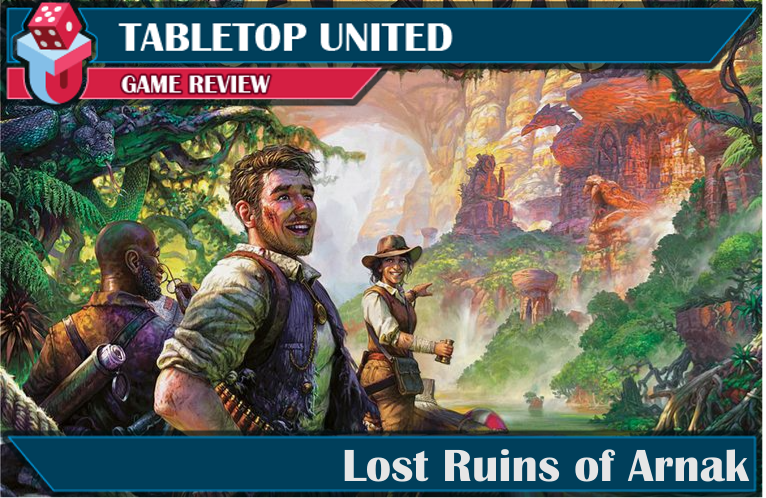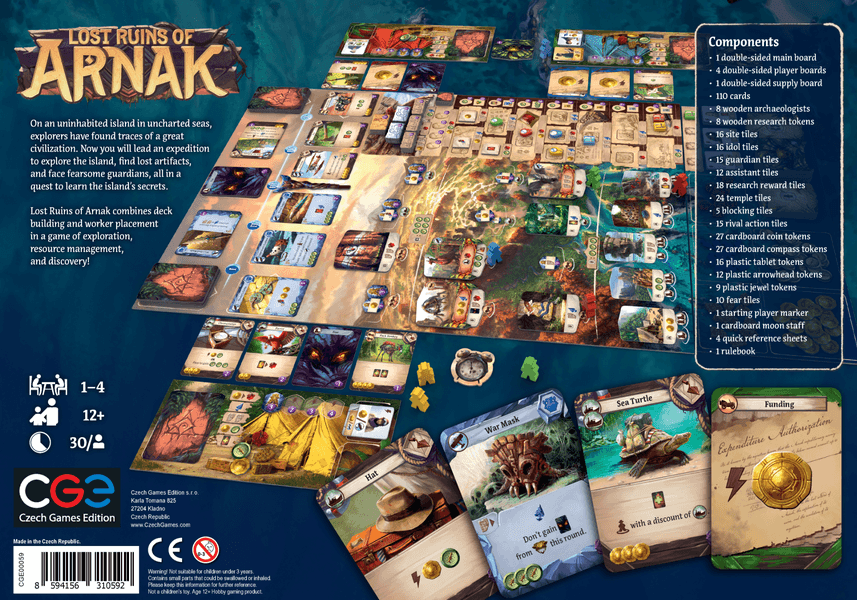
Lost Ruins of Arnak
Designer: Min and Elwin
Artist: Jiří Kůs, Ondřej Hrdina, Jakub Politzer, František Sedláček, and Milan Vavroň
Publisher: Czech Games Edition
Year Published: 2020
No. of Players: 1–4
Ages: 12+
Playing Time: 30 / player
Main mechanic / Theme: Deck building, worker placement, resources / Explore the jungles to find the ruins that hold treasure
Discover the ruins in the deep jungles where treasure and glory await.
Find more info on BoardGameGeek.com
Overview:
Lost Ruins of Arnak combines deck building, worker placement, and resources to search the wilderness for greater treasures. I was invited to join a four-player game of Lost Ruins of Arnak by a couple of my “convention spies” at the SaltCon End of Summer Event.

Gameplay and Mechanisms:
With two locations to gain more cards for your deck, resources, working placement, and the ability to advance your research, there are multiple routes to choose from for developing strategy. There are pieces to set up to start, but nothing difficult to figure out. It is a matter of shuffling up decks and placing pieces into piles.
Players start with a beginning deck and resources based on the starting order.
Each player takes an action on their turn. There are free actions that can also be taken. The combination of the action and free actions is how you purchase more cards, move your workers and advance your research. Each of those action results in building your deck, gaining resources, and scoring points.
The decks you can build remain small in comparison to many other deck building games I have played. This is because you are also placing workers to gain resources and to explore ruins, which your deck may be used for defeating the guardian when the encounter is explored the first time. Some exploration, card purchases, and research advancement also require resources. All of them play together and you can create some interesting and complex moves on or over several of the rounds during a game turn.
The game is divided into a set number of turns that are tracked by the cards available to be purchased. The number of resource cards goes down each turn and the number of artifact cards increases. When a cycle of turns is completed the game ends and scores are tallied.
Theme, Artwork and Illustration, Graphic Design and Layout
Lost Ruins of Arnak is visually a wonderful game. A team of artists were involved in the production, and you can tell they worked well together because the art is consistent with the theme and flavor of the game. I found the artwork to be appealing and reflective of a game I would enjoy having on my table.

Inclusivity and Accessibility:
Cards, tiles, and resource markers are used. I game with some people who have some physical limitations that these might be a little hard to manage on their own.
What Worked:
Lost Ruins of Arnak’s use of multiple mechanics is well-balanced. Our game was the first time any of us played Lost Ruins of Arnak. I mentioned I was invited by a couple of my convention spies, people I know who look for games they would like and think they should get more attention, who are experienced tabletop gamers. We had no problem picking up the combinations of play and how the game played from round to round and turn to turn.
Final Thoughts:
We all liked Lost Ruins of Arnak. Your focus is your own development, however, there is the ability to be competitive. I believe I came in second on this tightly matched game (7-point difference between first and fourth) due to being purposefully blocked by the person preceding me. I would have done the same in their position because they didn’t have a good play for developing their position, so they played to block my advancement.
I know a number of people who keep an eye out for single player games and Lost Ruins of Arnak can be played by 1 person.
I recommend Lost Ruins of Arnak to players who like complex strategy options.

About the Author
Daniel Yocom does geeky things at night because his day job won't let him. This dates back to the 1960s through games, books, movies, and stranger things better shared in small groups. He's written hundreds of articles about these topics for his own blog, other websites, and magazines after extensive research along with short stories. His research includes attending conventions, sharing on panels and presentations, and road-tripping with his wife. Join him at guildmastergaming.com.

